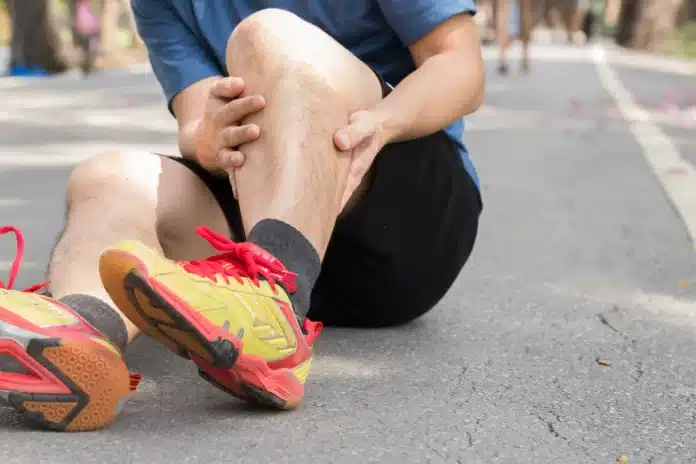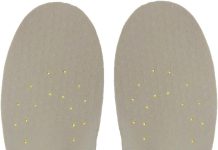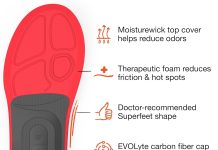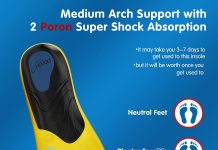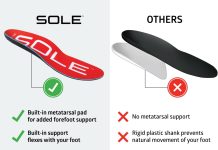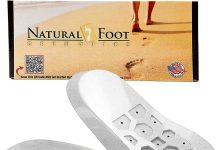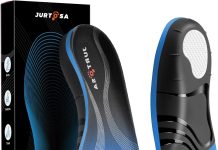Are you experiencing pain in your shins whenever you run, walk, or jump?
You might have shin splints. Shin splint is a common condition that affects athletes and non-athletes alike. It can be caused by various factors such as overuse, improper footwear, or poor biomechanics.
Fortunately, there are ways to prevent and treat this condition, including shoe inserts. In this blog post, we’ll explore the causes and symptoms of shin splints, how to treat them, and why shoe inserts can effectively prevent and treat this painful condition.
So if you’re tired of dealing with shin pain every time you exercise or move around, keep reading!
What are shin splints?
Shin splints, also known as medial tibial stress syndrome, are a condition that causes pain along the shinbone or tibia. It most commonly affects athletes who engage in high-impact activities such as running or jumping. However, anyone can experience this condition.
Shin splints are caused by repetitive stress on the shinbone and the tissues attached to it. This stress can cause tiny tears in the muscles and tendons of the lower leg, leading to inflammation and pain.
The main symptom of shin splints is pain along the inside edge of your shins. The pain may be sharp or dull and usually gets worse with activity. You may also experience swelling or tenderness in this area.
If left untreated, shin splints can lead to more severe conditions such as stress fractures. Therefore, seeking medical attention is essential if you’re experiencing persistent leg pain.
Luckily, there are ways to prevent and treat shin splints so you no longer have to suffer from this painful condition!
Causes of shin splints
Shin splints, also known as medial tibial stress syndrome, is a common condition that affects athletes and runners. It occurs due to overuse and repetitive strain on the shin bone and surrounding tissues. Several factors can contribute to the development of shin splints.
One of the leading causes of shin splints is a sudden increase in physical activity or exercise intensity. Pushing your body too hard without giving it enough time to adjust can lead to small tears in your muscles, which may cause pain and inflammation.
Another factor contributing to shin splints is improper footwear or worn-out shoes with little cushioning support. Poor biomechanics, such as flat feet or high arches, can also put extra pressure on your shins while running or walking.
Additionally, activities that involve abrupt stops and start, like basketball or tennis, can increase the risk of developing shin splints due to constant impact on the lower legs.
Understanding what causes shin splints will help prevent their occurrence in the future. One could reduce their chances of getting this painful condition by gradually increasing exercise intensity, wearing proper footwear with adequate support, maintaining good biomechanics, and avoiding activities with constant impacts.
Symptoms of shin splints
Shin splints are a common injury that affects athletes and people who engage in activities involving repetitive lower leg movements.
Here are some symptoms related to this condition:
Pain
The most common symptom of shin splints is pain along the tibia or shinbone, which can be felt as a dull ache or sharp pain that worsens with activity.
Swelling
Swelling around the affected area is another sign of shin splints. The swelling may be mild initially but can become more pronounced if left untreated.
Tenderness
Tenderness when touching the area is also an indicator of shin splints. This tenderness often accompanies feelings of pain and discomfort in the legs.
Redness
In severe cases, redness may occur over the affected area due to inflammation caused by repeated stress on the muscles and bones in your lower leg.
Suppose you experience any symptoms associated with Shin Splint Syndrome. In that case, it’s essential to stop any physical activity until evaluated by a professional healthcare provider who can recommend appropriate treatment options such as rest, ice therapy, compression garments, stretching exercises, or shoe inserts explicitly tailored for your needs!
How to treat shin splints
When it comes to treating shin splints, you can do a few things to alleviate the pain and discomfort. Rest is critical in the initial stages of treatment as it will give your body time to heal. Additionally, icing the affected area for 20 minutes at a time several times throughout the day can help reduce inflammation.
Stretching is also essential in both treating and preventing shin splints. Gentle calf stretches and toe raises can help strengthen the muscles in your lower legs and relieve tension in your shins.
Over-the-counter pain medication like ibuprofen or acetaminophen can be taken to manage pain if necessary. However, it’s important not to rely too heavily on these medications as they may mask symptoms without addressing underlying issues.
In more severe cases of shin splints, physical therapy may be recommended by a medical professional. This can include exercises focused on strengthening weak muscles or correcting imbalances contributing to shin splint development.
Remember that everyone’s body is different, so what works for one person may not work for another when treating their shin splints. If your symptoms persist or worsen despite rest and self-care measures, seek medical attention from a healthcare provider who specializes in sports medicine or podiatry specialized doctors.”
Shoe inserts for shin splints
Shin splints can be a frustrating and painful problem for many people, especially those who engage in high-impact activities like running or basketball. Fortunately, various treatments are available to help alleviate the pain and prevent further injury. One such treatment is the use of shoe inserts.
Shoe inserts can provide added support to the foot and ankle, which can help reduce stress on the shin muscles during physical activity. Inserts may also help correct any imbalances or pronation issues that could contribute to shin splints.
Several types of shoe inserts are available for those suffering from shin splints. Some are designed for athletic shoes, while others work well with everyday footwear. It’s essential to choose an insert that fits appropriately inside your shoe and provides adequate support to your feet.
Another benefit of shoe inserts is that they’re relatively inexpensive compared to other treatments like physical therapy or chiropractic care. They’re also easy to find at most sporting goods stores or online retailers.
It’s worth noting that while shoe inserts can help treat shin splints, they should not be used as a standalone solution. Combining them with stretching exercises, icing techniques, and proper rest periods will relieve this painful condition.
If you suffer from shin splints, using supportive shoe inserts as part of your recovery plan is worth considering.
Prevention of Shin Splints
Preventing shin splints is crucial for athletes and runners who want to avoid this painful condition. To prevent shin splints, engaging in proper warm-up exercises before a workout or run is essential. This helps prepare the muscles for physical activity, reducing the risk of injury.
Wearing correctly fitting shoes that provide adequate support is also essential in preventing shin splints. Shoes with good arch support can help reduce stress on the shins during physical activity.
Gradually increasing your workout intensity and duration over time rather than doing too much too soon can also prevent shin splints from occurring. This allows your body to adapt to increased physical demands gradually.
It’s also important to listen to your body and take rest days when needed. Overuse injuries like shin splints occur when you push yourself too hard without giving your body enough time to recover.
Incorporating strength training exercises that target the lower legs, such as calf raises and ankle dorsiflexion exercises, can strengthen the muscles around the shins and reduce the risk of developing shin splints.
By taking these preventative measures, you’ll be able to enjoy running or participating in sports without worrying about painful shin splints slowing you down!
Treatment of Shin Splints
Treatment of Shin Splints:
The treatment for shin splints can vary depending on the severity of the condition. Rest is often recommended to allow inflamed tissues to heal correctly. Ice therapy can also help reduce inflammation and pain.
In addition, stretching exercises and physical therapy may help relieve the symptoms of shin splints. These exercises can improve flexibility, strengthen muscles, and reduce tension in affected areas.
If rest and home remedies do not relieve shin splint pain, your doctor may recommend over-the-counter pain medications or prescribe more vital medication if necessary.
For severe cases, surgery may be required to repair damaged tissues or relieve pressure on nerves causing discomfort.
It’s important to note that self-treatment should only be done under proper guidance from a healthcare professional. It’s best to seek medical advice before attempting any treatment plan for shin splints.
Conclusion
Shin splints can be a painful and frustrating condition to deal with. However, they can be prevented and treated with suitable measures. Proper footwear is essential in preventing shin splints from occurring in the first place.
Investing in shoe inserts that provide cushioning and support for your feet can also help alleviate symptoms of shin splints.
If you’re experiencing pain or discomfort due to shin splints, it’s essential to seek treatment promptly. Rest, ice, compression, and elevation are effective ways to manage acute cases of this condition. Physical therapy exercises such as calf stretches and strengthening exercises may also help speed recovery.
Remember that prevention is always better than cure regarding shin splints. Taking proactive steps such as wearing appropriate shoes and using shoe inserts can significantly reduce your risk of developing this painful condition.
Take care of your feet by investing in proper footwear today!
Dr. Scholl’s Running Insoles // Reduce Shock and Prevent Common Running Injuries: Runner's Knee, Plantar Fasciitis and Shin Splints (For Women's 5.5-9, also Available for Men's 7.5-10 & Men's 10.5-14)
$14.85 in stock

